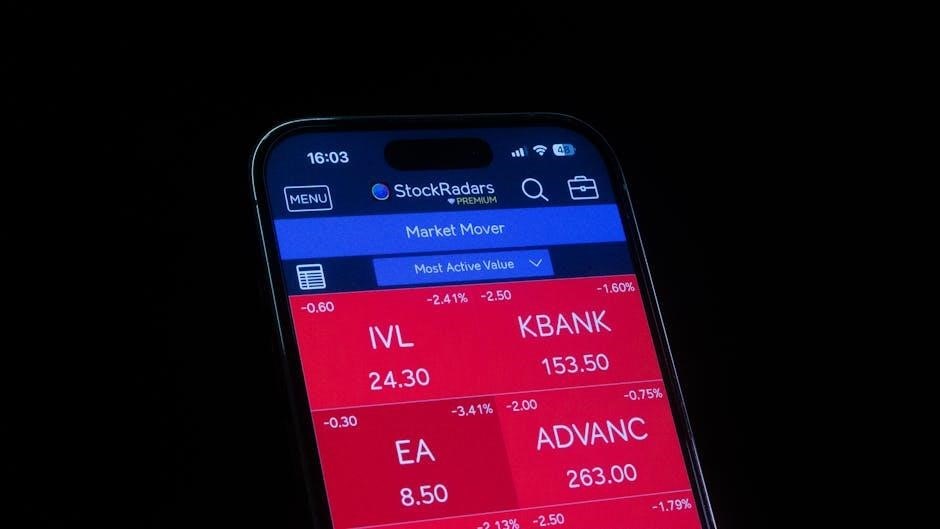A place value chart is a visual tool organizing numbers by their place value‚ from hundreds to thousandths‚ aiding in understanding decimal concepts and conversions.
1.1 What is a Place Value Chart?
A place value chart is a visual tool that organizes numbers by their place value positions‚ such as hundreds‚ tens‚ and ones for whole numbers‚ and tenths‚ hundredths‚ and thousandths for decimals. It helps students understand the relative value of each digit in a number‚ making it easier to read‚ write‚ and compare numbers. The chart often includes a decimal point to separate whole numbers from decimal places‚ providing a clear structure for learning place value concepts.
1.2 Importance of Place Value Charts in Mathematics
Place value charts are essential for building a strong foundation in mathematics‚ particularly in understanding decimal and whole number relationships. They simplify complex concepts like ordering‚ comparing‚ and rounding numbers. By visually organizing digits‚ these charts enhance problem-solving skills and improve accuracy in arithmetic operations. Additionally‚ they serve as valuable aids in state assessments and real-world applications‚ reinforcing mathematical literacy and critical thinking abilities for students of all learning levels.

Understanding Decimal Place Value
Decimal place value refers to the positional value of digits in a number‚ extending beyond the decimal point to tenths‚ hundredths‚ and thousandths‚ enhancing numerical understanding and precision.
2.1 Definition of Decimal Place Value
Decimal place value defines the positional value of digits in a number‚ extending beyond the decimal point. Each digit after the decimal represents fractions of a whole‚ such as tenths (1/10)‚ hundredths (1/100)‚ and thousandths (1/1000). This system allows precise representation of numbers less than one‚ enabling accurate calculations and comparisons. Understanding decimal place value is essential for working with money‚ measurements‚ and advanced mathematics. It forms the foundation for skills like rounding‚ estimation‚ and converting between standard and expanded forms.
2.2 Key Components of a Decimal Place Value Chart
A decimal place value chart typically includes columns for whole numbers (hundreds‚ tens‚ ones) and decimal places (tenths‚ hundredths‚ thousandths). It may also extend to hundred thousands and millionths for advanced learning. Each column is labeled to indicate its place value‚ helping users understand the positional significance of each digit. This structured format allows for clear visualization of how numbers are composed and compared‚ making it an effective tool for teaching and learning decimal concepts.
2.3 The Role of the Decimal Point
The decimal point is a crucial element in a place value chart‚ as it separates whole numbers from decimals. It indicates that the digits to its right represent fractions of a whole‚ rather than whole numbers. The decimal point helps organize and clarify the relationship between tenths‚ hundredths‚ and thousandths‚ making it easier to understand and work with decimal numbers. Its presence ensures accuracy in identifying place values and performing calculations.

Structure of a Decimal Place Value Chart
A decimal place value chart organizes numbers into whole numbers (hundreds‚ tens‚ ones) and decimals (tenths‚ hundredths‚ thousandths)‚ separated by a decimal point for clarity.
3.1 Whole Numbers: Hundreds‚ Tens‚ and Ones
A place value chart with decimals pdf typically begins with whole numbers‚ divided into hundreds‚ tens‚ and ones. Each column represents a specific value: hundreds (100)‚ tens (10)‚ and ones (1). These columns help students understand the relative size and positional value of digits. For example‚ the number 500 has five hundreds‚ zero tens‚ and zero ones. This section forms the foundational part of the chart before transitioning to decimal places‚ ensuring a clear understanding of place value concepts.
3.2 Decimal Places: Tenths‚ Hundredths‚ and Thousandths
In a place value chart with decimals pdf‚ decimal places are categorized into tenths‚ hundredths‚ and thousandths. Tenths represent fractions of a whole number‚ with each place valued at 1/10. Hundredths are smaller‚ at 1/100‚ and thousandths at 1/1‚000. These places help students visualize and compare decimals‚ such as 0.1 (tenths)‚ 0.01 (hundredths)‚ and 0.001 (thousandths). This structure makes understanding and working with decimals more accessible and organized for learners.
3.3 Extended Places: Hundred Thousands to Millionths
Extended places in a place value chart with decimals pdf include hundred thousands‚ million‚ ten-thousandths‚ hundred-thousandths‚ and millionths. These places extend beyond the basic tenths‚ hundredths‚ and thousandths‚ allowing for more precise representation of larger and smaller values. For example‚ 100‚000 is in the hundred thousands place‚ while 0.0001 is in the ten-thousandths place. This helps students and educators visualize and work with complex decimal and whole number relationships in a structured format.

Benefits of Using a Decimal Place Value Chart
A decimal place value chart enhances understanding of complex number concepts‚ making learning clearer and more engaging. It boosts confidence in manipulating decimals and whole numbers‚ aiding in real-world applications.
4.1 Improved Understanding of Decimal Concepts
A decimal place value chart provides a clear visual breakdown of numbers‚ helping learners grasp how tenths‚ hundredths‚ and thousandths relate to whole numbers. By organizing digits into place values‚ it simplifies complex concepts‚ making them easier to understand. This tool is particularly effective for visual and kinesthetic learners‚ as it offers a hands-on way to explore decimal structures. The chart also highlights the significance of the decimal point‚ ensuring a strong foundation for operations like addition‚ subtraction‚ and comparison of decimals.
4.2 Enhanced Skills in Ordering and Comparing Decimals
A place value chart with decimals PDF enhances the ability to order and compare decimals by providing a structured visual layout. Learners can easily identify how digits align in tenths‚ hundredths‚ and thousandths places‚ making comparisons more straightforward. This tool helps students recognize patterns and relationships‚ enabling them to determine which decimal is larger or smaller with greater accuracy. It also reduces errors by emphasizing the importance of aligning digits correctly during comparisons;
4.3 Better Estimation and Rounding Abilities
A place value chart with decimals PDF improves estimation and rounding skills by visually organizing digits into their respective places. Learners can quickly identify the significance of each digit‚ making it easier to round numbers to the nearest whole‚ tenth‚ or hundredth. This tool also supports estimating decimal values by emphasizing the relationship between digits‚ helping students develop a systematic approach to rounding and approximation tasks with greater confidence and accuracy.
4.4 Support for Academic Assessments
A place value chart with decimals PDF serves as an invaluable resource for academic assessments. It helps students master decimal concepts‚ ensuring better performance in math tests. By aligning with curriculum standards‚ the chart reinforces key skills like ordering decimals and understanding place value. Educators can use it to identify knowledge gaps‚ while students can rely on it as a reference during study sessions‚ making it a practical tool for achieving success in standardized and classroom assessments.

How to Use a Decimal Place Value Chart
Use the chart to identify decimal places‚ convert numbers‚ and compare values. It aids in understanding place value‚ enhancing math skills through clear visual representation and organization.
5.1 Identifying Places in a Decimal Number
A decimal place value chart helps students identify tenths‚ hundredths‚ and thousandths in a number. Starting from the decimal point‚ each position to the right represents a smaller place value. For example‚ 0.1 is tenths‚ 0.01 is hundredths‚ and 0.001 is thousandths. The chart visually organizes these places‚ making it easier for learners to understand and locate each digit’s position within a decimal number. This clarity enhances comprehension of place value patterns and relationships.
5.2 Converting Between Standard Form and Expanded Form
A decimal place value chart is an essential tool for converting numbers between standard form and expanded form. In standard form‚ a number like 3.456 is written as is‚ while expanded form breaks it down into place values: 3 + 0.4 + 0.05 + 0.006. The chart helps align each digit with its corresponding place value‚ making the conversion process clear and systematic. This visual aid supports students in understanding the relationship between digits and their positions in a decimal number.
5.3 Comparing Decimals Using the Chart
A decimal place value chart simplifies comparing decimals by aligning digits according to their place values. Students can easily identify which number has a greater value at each place‚ starting from the left. For example‚ comparing 2.53 and 2.45‚ the chart highlights that the tenths place (5 vs. 4) determines the larger number. This visual method enhances understanding and confidence in decimal comparisons‚ making it an invaluable classroom tool for teaching this fundamental math skill.
5.4 Real-World Applications of the Chart
A decimal place value chart is invaluable in real-world scenarios‚ such as budgeting‚ cooking‚ and science. For instance‚ it helps in accurately measuring ingredients for recipes or calculating costs in financial planning. Students can apply the chart to compare prices‚ convert units‚ or understand scales in maps and blueprints. These practical uses reinforce mathematical concepts‚ making the chart a versatile tool for everyday problem-solving and decision-making across various disciplines and industries.

Creating a Custom Decimal Place Value Chart
Creating a custom decimal place value chart involves designing a structure that includes whole numbers‚ decimals‚ and extended places. Add clear labels and customize it to meet specific learning needs for better understanding and engagement.
6.1 Steps to Design a Place Value Chart
- Determine the range of numbers needed‚ including whole numbers and decimals.
- Outline columns for ones‚ tenths‚ hundredths‚ thousandths‚ and beyond.
- Add rows for each place value‚ labeling them clearly.
- Include examples to demonstrate how numbers fit into each place.
- Use a grid or table format for easy readability.
- Customize the design to suit specific learning objectives or grade levels.
- Add visual cues or colors to highlight important concepts.
- Review and test the chart with sample numbers to ensure accuracy.
6.2 Including Tenths‚ Hundredths‚ and Thousandths
When designing a place value chart‚ it’s essential to include columns for tenths‚ hundredths‚ and thousandths to represent decimal places. Each column should be labeled clearly to indicate its value‚ such as 0.1‚ 0.01‚ and 0.001. This helps students visualize how decimals extend beyond whole numbers. Use visual separators or lines to distinguish between whole numbers and decimal places‚ ensuring clarity and ease of understanding. This structure aids in converting between standard and expanded forms of decimal numbers.
6.3 Adding Labels for Clarity
Adding clear labels to your decimal place value chart is crucial for effective learning. Use bold headings to distinguish between whole numbers and decimal places‚ ensuring each column is clearly marked. Labels like “Tenths‚” “Hundredths‚” and “Thousandths” help students quickly identify each place. Consider using color-coding or symbols to further enhance readability. Clear labels make the chart user-friendly‚ especially for visual learners‚ and ensure that students can easily recognize and understand the value of each position in a decimal number.
6.4 Customizing for Specific Learning Needs
Customizing a decimal place value chart allows it to meet diverse learning needs. For visual learners‚ use color-coding to highlight different place values. For kinesthetic learners‚ incorporate interactive elements like movable tokens or flaps. Add tactile markers for students with special needs. Include images or symbols for younger learners. Tailor the chart to focus on specific decimal places or extend it for advanced concepts. Customization ensures the chart is accessible and engaging for all students‚ supporting individual learning styles and abilities effectively.

Printable Decimal Place Value Charts
Printable decimal place value charts are readily available online for free‚ offering a clear and structured way to visualize decimal concepts. They are perfect for classroom or homework use‚ providing an effective tool for enhancing math skills and understanding place value.
7.1 Sources for Free Printable Charts
Free printable decimal place value charts are available on educational websites like Teachers Pay Teachers‚ Math Aids‚ and Google Classroom. These platforms offer downloadable PDFs designed for classroom use‚ ensuring students can grasp decimal concepts visually. Many charts are customizable to cater to different learning needs‚ making them ideal for both teachers and homeschooling parents. They are also suitable for students who benefit from hands-on learning tools to master place value understanding effectively.
7.2 Features of a Printer-Friendly Chart
A printer-friendly decimal place value chart typically features a clean‚ high-resolution design with clear fonts and proper alignment. Color-coded sections help distinguish between whole numbers and decimal places‚ while labels ensure clarity. The chart should be optimized for standard paper sizes to avoid scaling issues. Many versions are designed to print in both color and black-and-white‚ making them accessible for all classrooms. The layout is organized to prevent clutter‚ ensuring readability and ease of use for students and educators alike.
7.3 Tips for Printing and Using the Chart Effectively
To ensure optimal results‚ print the chart on high-quality paper in standard sizes like A4 or letter. Use high-resolution settings to maintain clarity. Laminate the chart for durability and repeated use. Mount it on a wall or place it on a desk for easy reference. Use markers or colored tabs to highlight key sections. Encourage students to interact with the chart by circling or underlining place values during lessons. Regularly review and update the chart to keep it relevant and engaging for learners.

Integrating the Chart into Curriculum
Integrate the place value chart into math lessons by aligning it with curriculum standards and incorporating it into daily instruction for enhanced student engagement and understanding.
8.1 Aligning with Math Standards
Aligning the place value chart with math standards ensures it supports curriculum goals‚ such as understanding decimal concepts and place value. The chart serves as a visual aid to break down numbers into hundreds‚ tens‚ ones‚ tenths‚ hundredths‚ and thousandths‚ aligning with grade-level expectations. It reinforces skills like ordering‚ comparing‚ and estimating decimals‚ while its structure mirrors math standards focused on number sense and operations. This alignment makes the chart an effective tool for meeting educational benchmarks and fostering deeper mathematical understanding.
8.2 Incorporating into Lesson Plans
Incorporating a place value chart into lesson plans enhances teaching strategies for decimal concepts. Teachers can use the chart to introduce lessons‚ model place value understanding‚ and support guided practice. It can also serve as a visual anchor for independent work‚ helping students identify and compare decimal places. By integrating the chart into daily instruction‚ educators create a structured and engaging approach to mastering decimal place value‚ making abstract concepts more tangible for learners.
8.3 Using the Chart as a Supplemental Aid
A decimal place value chart serves as an effective supplemental aid‚ reinforcing lessons and providing visual support for students. It can be used during small group instruction or one-on-one tutoring to address specific learning gaps. The chart helps students connect abstract decimal concepts to concrete representations‚ making it easier to grasp place value relationships. Additionally‚ it can be referenced during homework or independent practice to ensure understanding and accuracy in decimal-based tasks.

Additional Resources and Tools
Enhance your learning journey with supplementary materials like blank charts‚ answer sheets‚ and interactive online tools to master decimal place value concepts effectively.
9.1 Blank Decimal Place Value Charts
Blank decimal place value charts are essential tools for students to practice identifying and filling in decimal places. These charts typically include columns for ones‚ tenths‚ hundredths‚ and thousandths‚ along with rows for different numbers. They allow students to visually organize and understand the structure of decimals. Teachers can customize blank charts to focus on specific skills‚ such as tenths and hundredths for younger learners or extended places for advanced students. Blank charts are ideal for hands-on practice and can be easily integrated into classroom activities or homework assignments. They are widely available online as printable PDFs‚ making them accessible for educators and students alike. These resources help students develop a strong foundation in decimal place value‚ reinforcing their understanding through interactive and engaging exercises. Regular use of blank charts can improve accuracy and confidence in working with decimals.
9.2 Answer Sheets and Worksheets
Answer sheets and worksheets complement blank decimal place value charts by providing structured exercises and solutions. These resources offer a variety of problems‚ such as identifying decimal places‚ converting numbers‚ and comparing values. Worksheets often include charts for students to fill in‚ while answer sheets serve as references for self-checking or grading. They are designed to reinforce learning and ensure mastery of decimal place value concepts. Many worksheets are available as PDFs‚ making them easy to print and distribute in classrooms or for homework. They cater to different skill levels‚ offering targeted practice for tenths‚ hundredths‚ and thousandths‚ as well as extended places. Regular use of these materials helps students build confidence and accuracy in handling decimals‚ while teachers can track progress effectively. Answer sheets and worksheets are invaluable for reinforcing lessons and preparing students for assessments.
9.3 Online Interactive Tools
Online interactive tools offer engaging ways to explore decimal place value concepts. These tools often feature digital place value charts‚ allowing users to manipulate and visualize decimals dynamically. Interactive simulations enable students to drag-and-drop place value blocks or click to highlight decimal positions‚ enhancing understanding. Many tools provide real-time feedback and personalized learning paths. They cater to diverse learning styles‚ making complex concepts accessible. Accessible on various devices‚ these tools are ideal for classroom use or independent study‚ fostering an interactive and immersive learning experience.
A place value chart with decimals pdf is an essential tool for mastering decimal concepts‚ offering clarity and precision in understanding place values.
10.1 Summarizing Key Points
A place value chart with decimals pdf simplifies understanding of decimal place values‚ enhancing math skills and conceptual clarity. It effectively organizes numbers into whole and decimal places‚ aiding in accurate identification and comparison. Regular use improves estimation‚ rounding‚ and problem-solving abilities‚ making it a valuable resource for both students and educators. Its structured format ensures comprehensive learning‚ aligning with curriculum standards and supporting academic success in mathematics.
10.2 Encouraging Further Learning
To foster deeper understanding‚ encourage students to apply place value charts to real-world math problems‚ such as measuring lengths or calculating prices. This practical application reinforces decimal concepts and builds confidence. Additionally‚ integrating digital tools or interactive resources can enhance engagement and provide varied learning experiences. Regular practice with the chart helps solidify skills‚ preparing students for more advanced problem-solving in mathematics.

Downloading the PDF Version
The PDF version of the place value chart with decimals offers a convenient and accessible resource for teaching and learning. Download it easily for offline use.
11.1 Steps to Access the PDF
To access the place value chart with decimals PDF‚ visit the official website or resource page. Locate the download section and click on the provided link. Follow the prompts to complete the download process. Ensure your device has a PDF reader installed. Save the file to your desired location for easy access. This resource is designed to aid in understanding and teaching place value concepts effectively.
11.2 Using the PDF for Educational Purposes
The place value chart with decimals PDF is a versatile tool for teaching and learning. Print it for classroom use‚ distribute as a study guide‚ or project it for group activities. Teachers can use it to demonstrate decimal concepts‚ while students can reference it for homework or practice. The PDF’s clear layout makes it ideal for interactive lessons or as a quick reference for understanding place value patterns in decimals.

